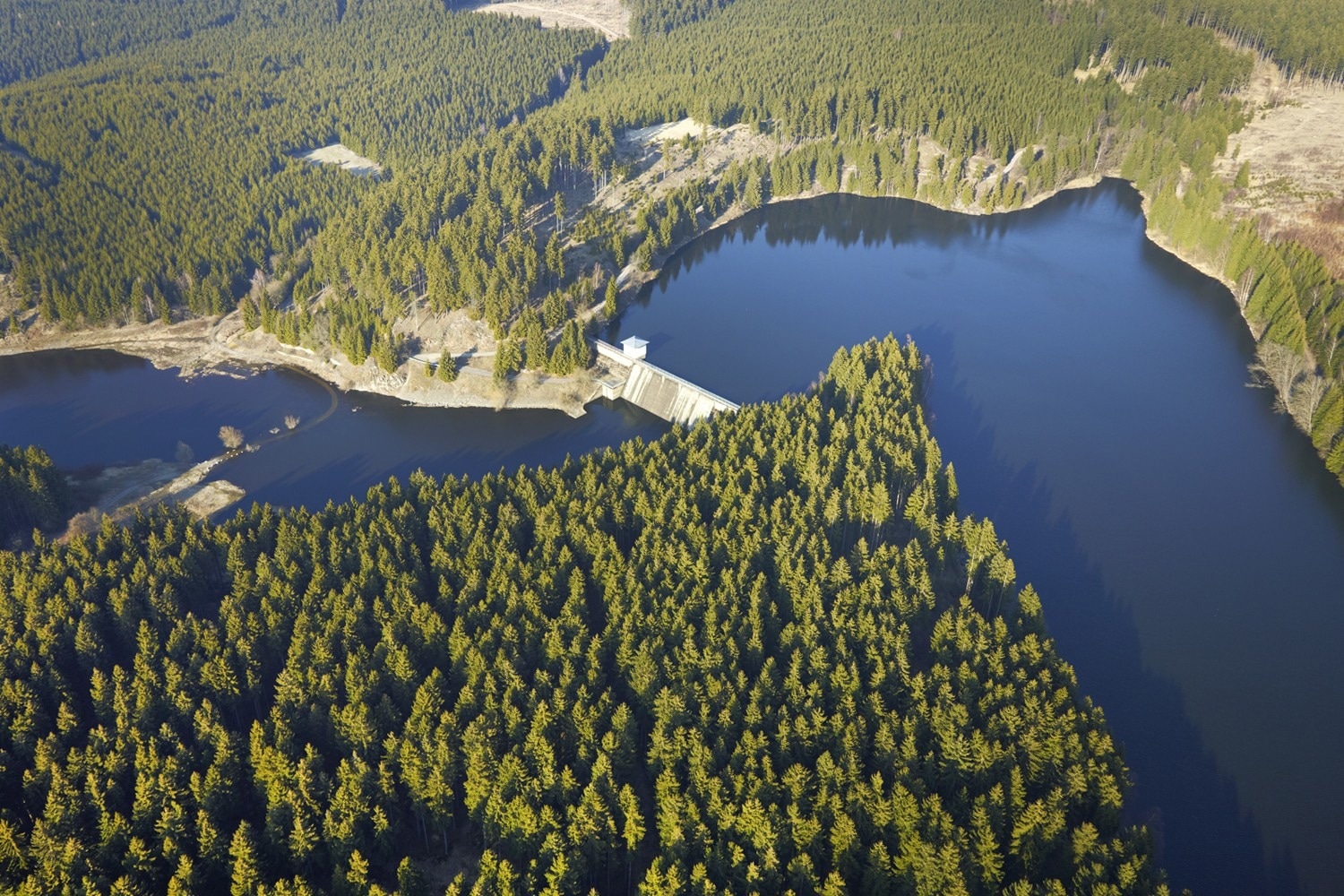Reviewed by Mila PereraSep 12 2022
Reservoirs ensure a consistent supply of drinking water, however, water quality is coming under threat due to climate change.
 The Rappbode reservoir in the Harz region is surrounded by forests and is the largest drinking water reservoir in Germany. Image Credit: André Künzelmann/UFZ.
The Rappbode reservoir in the Harz region is surrounded by forests and is the largest drinking water reservoir in Germany. Image Credit: André Künzelmann/UFZ.
A research team from the Helmholtz Centre for Environmental Research (UFZ) showed how water quality could be impacted by the climate-related loss of forests in the catchment area for Germany’s largest drinking water reservoir, the Rappbode reservoir in the Harz region.
The experts warn in Water Research that the problem of such indirect effects of climate change is grossly underestimated. In drinking water reservoirs, water quality is essential since subsequent treatment in the waterworks must consistently fulfill strict standards.
Heat waves, droughts, floods, and forest fires are just a few of the effects of climate change that are becoming more prevalent and altering the ecosystem. The terrain in the catchment area for the Rappbode reservoir in the eastern Harz region is an excellent illustration.
This reservoir, which holds the most drinking water in all of Germany, serves about a million people. The Harz region’s tree population has been severely affected by a prolonged drought from 2015 to 2020, which has allowed parasites such as bark beetles to flourish. The trees were further harmed, and they quickly withered away.
Over the past four years, the Rappbode catchment area, characterized by conifers, primarily spruce, has lost over 50% of its forest. This massive forest dieback is advancing rapidly and is dramatic. This will have consequences for the drinking water reservoir.
Michael Rode, Study Last Author and Hydrologist, Helmholtz Centre for Environmental Research
At the heart of the water cycle are forests. They serve to filter the water and bind nutrients, making them essential for high-quality water. The less nitrogen or phosphorus compounds a reservoir’s water contains, the better it is for treating drinking water.
This makes it more difficult for algae to develop, making drinking water treatment in the waterworks more cost-effective and easier. Nutrient management in water conservation areas is therefore very important. Over the past decades, long-term concepts with close cooperation between forest and water management have advanced the development of large areas of forest in the Rappbode reservoir catchment area.
Dr Karsten Rinke, Study Co-Author and Lake Researcher, Helmholtz Centre for Environmental Research
The operators of the reservoir and waterworks are now extremely concerned about the rapid forest degradation in the eastern Harz region.
In response to this shift, the UFZ team’s model study has examined how deforestation brought on by the climate affects the quality of reservoir water. The UFZ and the Harz/Central German Lowland Observatory are members of the TERENO (Terrestrial Environmental Observatories) environmental observatory network, which provided the data for this study.
We were able to access environmental data from a period of over ten years, providing us with a solid set of data. We first fed these data into a model in order to estimate the climate-related effects on the nutrient balance in the catchment area.
Dr. Xiangzhen Kong, Study Lead Author and Environmental Scientist, Helmholtz Centre for Environmental Research
The researchers made predictions about future climate changes using information from the global ISIMIP project (Inter-sectoral Impact Model Intercomparison Project).
Dr. Kong added, “The resulting data were then processed in a reservoir ecosystem model with which we were able to determine the effects of different deforestation scenarios on the predicted water quality for 2035.”
Three distinct catchment areas, of which two were studied, supply the Rappbode reservoir.
“The Hassel catchment area is characterized by agriculture, while that of the Rappbode is predominantly forest—at least that was the case before the spruce forests died,” Dr. Kong stated.
An upstream pre-dam first holds back the water from the two catchment areas before it enters the large Rappbode reservoir. Due to agricultural influences, the Hassel pre-dam has significantly more nutrients in its water than the Rappbode pre-dam.
Dr. Kong further stated, “We were able to demonstrate that, for an anticipated deforestation of up to 80%, the Rappbode predam will experience an 85% increase in dissolved phosphorus concentration and a more than 120% increase in nitrogen concentration within only 15 years. The Rappbode pre-dam will thus reach nearly the same nutrient levels as the Hassel pre-dam.”
The Rappbode pre-dam will see an increase in diatoms of more than 80% and green algae of more than 200%. These findings demonstrate the impending need for numerous drinking water management changes.
“Nutrient input to reservoir catchment areas should be reduced even more than previously, reforestation projects with drought-resistant tree species should be further promoted and waterworks should be adapted to the impending developments with selective water removal strategies. And what remains important and must be further increased: extensive, granular environmental monitoring,” Rode added.
Other reservoir catchment areas in neighboring regions can use the Rappbode reservoir’s results as a reference.
Dr. Kong concluded, “Forest dieback as an indirect consequence of climate change has a more pronounced effect on reservoir water quality than direct effects of climate change such as elevated water temperature. We were actually surprised by the extent of this effect.”
Journal Reference:
Kong, X., et al. (2022) Reservoir water quality deterioration due to deforestation emphasizes the indirect effects of global change. Water Research. doi:10.1016/j.watres.2022.118721.